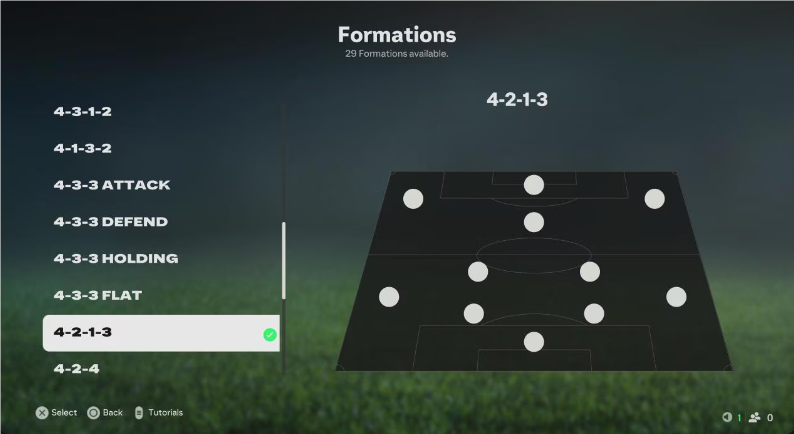FC 25 Formation Changes
Formations remain a fundamental aspect of football strategy in FC 25, though they no longer dictate your playstyle as heavily as in the past. However, they are still crucial in shaping your team’s structure, especially when your side is defending. The formation determines which positions and roles are available for you to assign to players, making it an essential part of building your tactic.
Defensive Structure & Formation
The formation you choose in FC 25 defines your team’s structure when they don’t have possession. While your playstyle and player behavior may adapt to various phases of the match, the formation is the blueprint for how your team lines up defensively.
Additionally, Player Roles within your formation will influence how players perform their duties, meaning that your formation serves as a foundation for your players’ movements and decisions during the match.

FC 25 Formation Adjustments
In the development of FC 25, several formations were adjusted or removed entirely to streamline tactical options and better reflect modern football. These adjustments include changes to traditional formations and the removal of certain positions, like CF (Centre Forward), RWB (Right Wing-Back), and LWB (Left Wing-Back), which directly impacted certain formations.
Formations Removed:
The following formations were removed from the game, though alternative variations remain available:
- 4-4-1-1 Attack (Other variations still exist)
- 4-3-3 (5)
- 5-2-2-1
- 5-4-1 Diamond (Other variations still exist)
- 5-1-2-1-1
- 3-5-1-1
- 3-4-3 Diamond (Other variations still exist)
Formations Adjusted:
Several formations underwent adjustments due to position changes:
- 4-3-2-1: Two CFs replaced by two CAMs.
- 3-4-2-1: Two CFs replaced by two CAMs.
- 5-3-2: RWB/LWB replaced by RB/LB.
- 5-2-3: RWB/LWB replaced by RB/LB.
- 5-2-1-2: RWB/LWB replaced by RB/LB.
These changes reflect the removal of certain roles like CF, RWB, and LWB and their substitution with more traditional positions like CAM, RB, and LB. The goal behind these adjustments is to provide a more streamlined experience across all modes of the game, ensuring formation consistency while offering tactical flexibility.
Formation Versatility and Roles
Even though formations are less influential in defining your team’s playstyle than before, they are critical in determining player behavior within the structure. Your chosen formation dictates the Roles available to your players and thus influences their movements, attacking runs, and defensive positioning.
For example:
- A 4-3-2-1 formation now gives you the opportunity to assign two CAMs instead of CFs, which shifts the focus from a traditional two-striker system to one that relies more on midfield creativity.
- A 5-3-2 formation now utilizes RBs/LBs instead of wing-backs, offering more defensive solidity while slightly reducing wide attacking support.
Formation Across All Modes
One of the key improvements in FC 25 is the goal to ensure the same formations are available across all game modes. Whether you’re playing in Career Mode, Ultimate Team, or any other mode, you can expect to see the same formation options, creating cohesion and consistency across your football experience.
Conclusion
In FC 25, formations continue to be a vital part of your tactical setup, particularly in shaping your team’s defensive line and offering specific roles to players. While the changes to certain formations may require tactical adjustments, they provide greater flexibility and better reflect the modern game. Understanding how these changes impact your players and strategy will be crucial to success on the pitch.
Similar Posts
- FFXIV Gathering High-Value Materials for Gil
- PoE Danning, The Blacksmith – Path of Exile
- FC 25 Vitality Stadium
- Diablo 4 Expert Difficulty
- PoE Scarabs, Chisels and Horizon Orbs drop rates – Path of Exile
- FC 25: Ülker Stadyumu Stadium Overview
- FC 25 MHPArena Stadium
- PoE Cyclone of Tumult Build 3.25 – Path of Exile: Settlers of Kalguur
- FC 25 Tactical Settings
- Diablo 4 Torment Difficulty & Unlock
- PoE Tincture Passive Masteries – Path of Exile
- PoE Magnificent Mastery Guide
- Diablo 4 Runewords: Offering – Unleashing the Power of Runes
- PoE The Battle Within – Path of Exile
- PoE Tremendous Township: Fully upgrade all of Kingsmarch